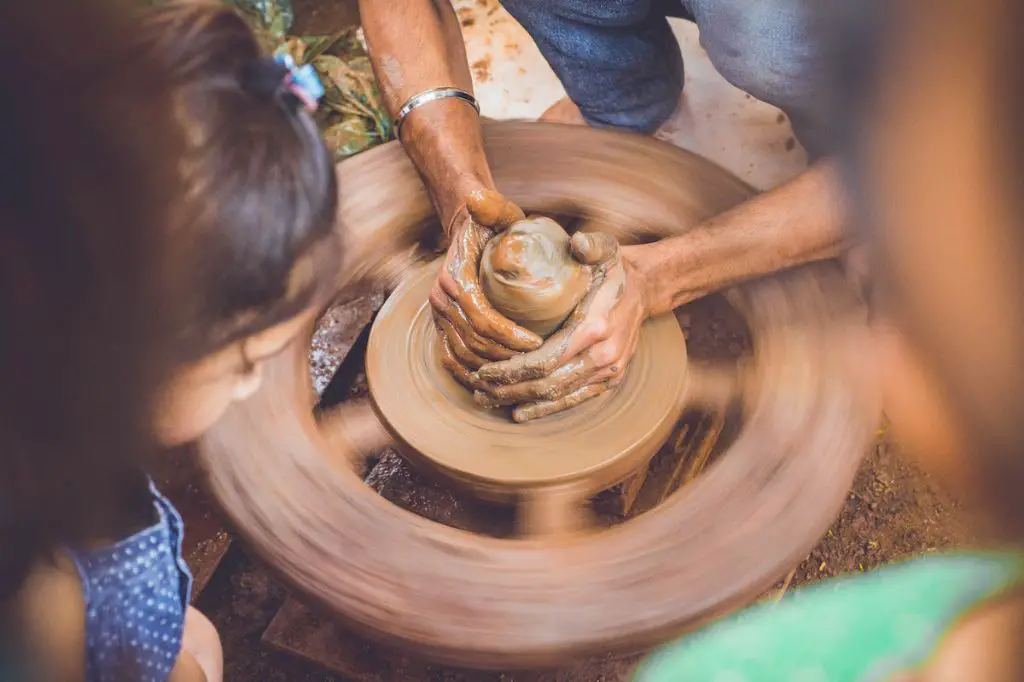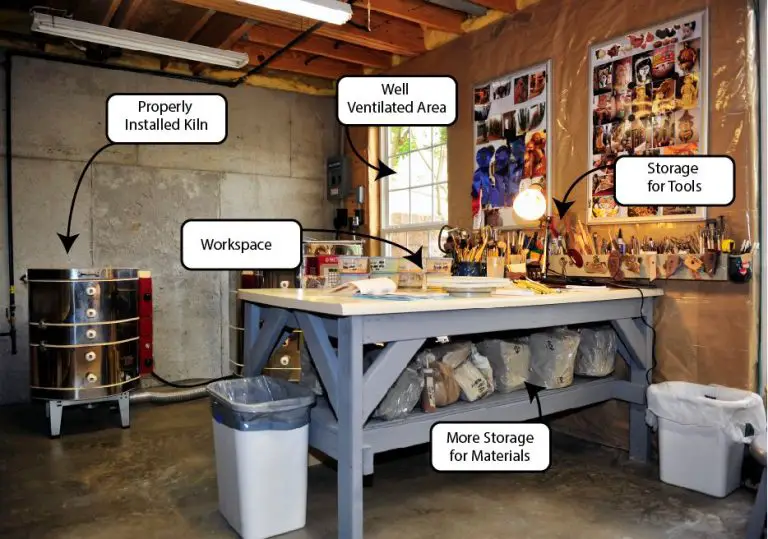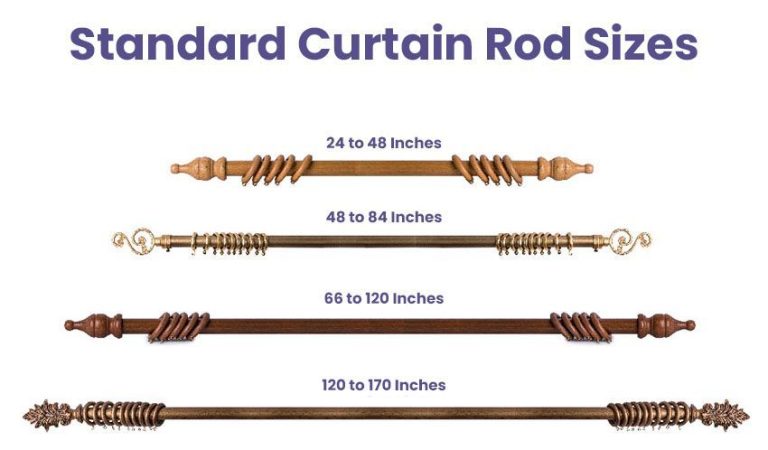What Is The Spinning Wheel Called In Pottery?
A pottery wheel, also known as a potter’s wheel, is a rotating circular platform used in the shaping process of pottery creation. The wheel allows potters to quickly and evenly shape wet clay into symmetrical pottery forms with thinner walls than handbuilding techniques. Centuries before the invention of the mechanical wheel, potters created basic wheels that could be spun by hand or foot to aid in manual formation of clay vessels.
The use of the potter’s wheel is universal in most pottery production because it greatly increases the efficiency and consistency of manufacturing while allowing for more delicate and balanced forms. When seated at the wheel, a potter can use both hands simultaneously to mold the rotating clay. The process of shaping clay on the wheel is known as “throwing.” Modern pottery wheels can be powered by motors, pedals, or hand-cranking to achieve the desired spinning speed.
Names for the Pottery Wheel
The pottery wheel, which is essential equipment for potters working with clay, has had several different names throughout history. Some of the most common names include:
- Potter’s wheel – This is the most widely used and recognized name for the rotating disk that potters use to shape clay vessels and other ceramic wares. “Potter’s wheel” refers to the fact that this tool is specifically used by potters.
- Kicking wheel – Early versions of the pottery wheel were operated by the potter kicking a lever with their foot to keep the wheel head spinning. Thus, these non-electric wheels were often referred to as “kicking wheels.”
- Tournette – This French term translates to “small lathe” and refers to a smaller, lighter pottery wheel that can be operated by hand. Tournettes allow for more portability.
- Electric wheel – Modern pottery wheels are mostly powered by electricity rather than human power. Hence, they are commonly known as “electric wheels” to differentiate them from traditional kick wheels.
While other names exist, potter’s wheel, kicking wheel, tournette, and electric wheel are among the most prominent terms used to describe this essential pottery tool throughout history and across different cultures and languages.
History of the Pottery Wheel
The origins of the pottery wheel can be traced back to ancient Mesopotamia, located in modern day Iraq. Evidence suggests the potter’s wheel was in use as early as 3500 BCE. The technology then spread to other ancient civilizations including Egypt, Greece, Rome and China.
In Mesopotamia, the early potter’s wheels were made of stone or clay and spun by hand. Potters would form rounded pots by shaping wet clay rotated on top of a stone disk. The first wheels were slow, but allowed potters to produce more uniform pots than with hand modeling alone.
The potter’s wheel revolutionized pottery production across many ancient cultures. In Egypt, wheels appeared around 2000 BCE, enabling the creation of delicate wares. Greek potters adopted the fast wheel around 600 BCE, bringing new levels of thinness and symmetry. The Romans developed the kick wheel in roughly 100 CE, which used momentum from the potter’s foot to spin faster. And the Chinese improved rotation speed with a friction wheel as early as 500 CE.
Over centuries of innovation across civilizations, the potter’s wheel enabled pottery-making on an entirely new scale, with more precision and efficiency than ever before possible.

Basic Design and Mechanics
The basic design of a pottery wheel involves a spinning disk or wheel head that rotates around a central shaft or axis. This spinning disk, sometimes called a flywheel, is connected to some mechanism that provides rotational force. In the earliest pottery wheels, this rotational force came from the potter kicking a large flywheel with their foot, known as a kick wheel. Later iterations involved a wheel operated by an assistant treadling a lever that spun the wheel, known as a treadle wheel.
Modern pottery wheels use an electric motor to provide the spinning force. The motor spins an axle that is connected to the wheel head by a drive belt or direct drive. The wheel head sits on a steel or cast iron bearing that allows it to spin freely. The motor speed is controlled by a pedal that the potter presses to speed up or slow down the wheel.
The clay sits on the spinning wheel head as the potter shapes it using their hands. The centrifugal force provided by the spinning wheel allows the clay to be pushed up and shaped into various forms and vessels. This process of using a pottery wheel to shape clay vessels is known as “wheel throwing” or throwing on the wheel. The potter’s hands never actually touch the spinning disk itself during wheel throwing.
The pottery wheel’s simple yet ingenious mechanism allows potters to efficiently and consistently produce symmetrical ceramic vessels with thin walls and elegant shapes. It revolutionized pottery production starting in ancient Mesopotamia and continuing to modern times. The basic design and mechanism enables the unique pottery wheel throwing process that remains popular today.
Types of Wheels
There are three main types of pottery wheels: kick wheels, electric wheels, and treadle wheels.
Kick Wheel
The kick wheel is the most traditional type of pottery wheel and has been used for thousands of years. It consists of a spinning wheel head that is connected to a heavy flywheel below. The potter uses their foot to kick the flywheel to provide momentum that spins the wheel head.1
Electric Wheel
Electric pottery wheels utilize an electric motor to spin the wheel head at a consistent speed. The speed can be precisely controlled with a pedal or knob. Electric wheels provide more consistent spinning and do not require as much physical effort as kick wheels.2
Treadle Wheel
Treadle wheels operate by using a foot pedal connected to a crank mechanism that spins the wheel head. The potter pumps the treadle to build momentum. Treadle wheels have the physical involvement of kick wheels but with more speed consistency.3
Wheel Throwing
Wheel throwing is the process of using a pottery wheel to shape clay into various forms and objects. It requires practice and skill to center the clay on the wheel and manipulate it into the desired shape.
The first step in wheel throwing is wedging and centering the clay on the wheel. Wedging ensures the clay is free of air bubbles, while centering allows the potter to achieve symmetry in the finished piece. To center, the potter places a ball of clay on the wheel and applies pressure while rotating the wheel head. Once centered, the clay is ready to be opened and shaped.
Opening the clay involves pushing thumbs into the center and widening the walls while applying pressure from the outside. This forms the general shape of the pottery piece. The next step is pulling up the walls to the desired height by placing one hand inside and the other outside the clay walls and pulling up in a smooth, even motion. Additional clay can be added and re-centered as needed throughout the process.
Trimming excess clay is the final step in finishing a thrown piece. A special trimming tool cuts away rough edges and refines the shape after the clay has partially dried. Proper wheel throwing technique allows potters to create symmetrical, thin-walled ceramics with uniform shape and wall thickness.[1]
Advantages of the Wheel
Using a pottery wheel offers several advantages for potters over handbuilding techniques. The main benefits are increased speed, consistency, smooth surfaces, and the ability to create new shapes.
The rotating motion of the wheel head allows potters to quickly shape, raise, and smooth clay into uniform pieces. Forming pots by hand can be very time consuming, whereas the wheel allows efficient, consistent production.[1] The momentum of the spinning clay enables potters to shape, trim, and alter forms rapidly.
In addition to speed, throwing on the wheel results in very uniform pieces with smooth, even surfaces. The centrifugal forces smooth out any irregularities in the clay. It can be difficult to achieve such consistency handbuilding without extensive work. The wheel naturally creates smooth walls and edges.[2]
Furthermore, the wheel allows access to new forms not possible by handbuilding alone. Throwing enables perfectly symmetrical pieces, delicate thin walls, and refined shapes like handles and spouts. While handbuilding can make similar forms, the precision and consistency is greatly enhanced with the wheel.[3]
Limitations of the Wheel
While the pottery wheel enables efficient production of round vessels and bowls, it does have some limitations:
The wheel has size constraints – very large or very small pieces are challenging to throw. Most wheels can accommodate clay up to 25-30lbs, limiting the maximum size of pieces.[1] Extremely tiny pieces are difficult as well due to the momentum of the spinning wheel.
Using the wheel successfully requires skill and practice – beginning potters will not immediately produce beautiful ceramics. It takes time to learn how to center clay properly, raise walls evenly, and trim pieces.[2] Experienced throwers make it look easy, but it requires coordination and muscle memory.
The wheel has some limitations for detailed sculpture – While elegant shapes emerge easily from wheel throwing, highly detailed sculptural elements do not. The centrifugal forces from the spinning wheel resist fine details. As such, handbuilding or combining wheel thrown parts may be preferable for intricate sculpture.[3]
So in summary, the pottery wheel excels at round functional ware and vessels but has constraints around size, skill required, and detail.
[1] https://ceramic.school/pottery-wheels/
[2] https://amyleepottery.com/blogs/news/colorful-cheap-o-imported-wheels-pros-and-cons-by-amy-lee
[3] https://www.thesprucecrafts.com/pros-and-cons-of-throwing-on-the-potters-wheel-2745826
Notable Potters Who Use the Wheel
Many of history’s most renowned potters have used the pottery wheel to create their works of art. Here are a few standout potters who relied on the wheel:
Bernard Leach was an English studio potter who helped pioneer the revival of traditional Oriental ceramic methods in the West. Along with his friend Shoji Hamada, he emphasized the importance of handcrafted pottery produced using the traditional potter’s wheel. Leach authored the influential book A Potter’s Book, which discusses his philosophies on pottery and the importance of the potter’s wheel in creating handmade pottery.
Shoji Hamada was a Japanese potter who became known for combining traditional Japanese pottery styles with a more modern sensibility. He frequently used the potter’s wheel in his work. Hamada worked closely with Bernard Leach and helped introduce him to Japanese pottery techniques.
Lucie Rie was an Austrian-British potter who moved to London in 1938 after fleeing Nazi occupation. She became known for her modernist ceramic works, many of which were thrown on the potter’s wheel. Rie emphasized elegance and simplicity in her pottery. She was accomplished at producing intricately shaped bottles, bowls, and other vessels using the wheel.
Conclusion
The pottery wheel, sometimes referred to as the potter’s wheel, has been an essential tool for potters and ceramic artists for thousands of years. Its design allows the potter to quickly and symmetrically shape clay into precisely formed vessels and bowls. While the basics of the wheel have remained unchanged, modern wheels employ electric motors for spinning and include variable speed controls.
The pottery wheel enables the creation of round pots and bowls with thinner, more uniform walls than can be achieved with handbuilding techniques like pinch pots or coil building. It introduces efficiencies and new creative possibilities to the ceramic artist. While the earliest known use of the wheel was thousands of years ago, it remains an indispensable tool for studio potters and ceramic artists working today. The wheel allows expression of both symmetry and asymmetry within the clay medium. Whether used alone or in conjunction with handbuilding techniques, the wheel will likely continue to be a foundational part of pottery and ceramic art for years to come.






